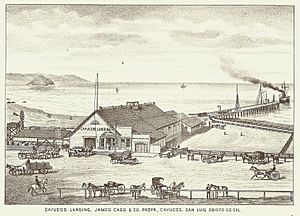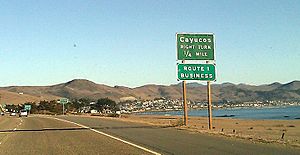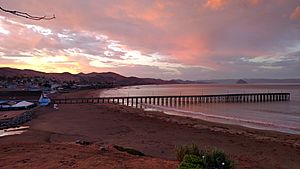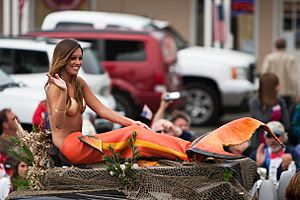Cayucos, California facts for kids
Quick facts for kids
Cayucos, California
|
|
|---|---|
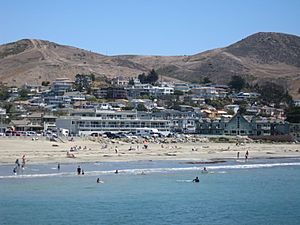
Cayucos viewed from the town pier
|
|
| Nickname(s):
Little Slice of Paradise
|
|
| Motto(s):
Last of the California beach towns
|
|
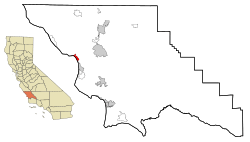
Location in San Luis Obispo County and the state of California
|
|
| Country | |
| State | |
| County | San Luis Obispo |
| Area | |
| • Total | 4.03 sq mi (10.45 km2) |
| • Land | 3.10 sq mi (8.03 km2) |
| • Water | 0.93 sq mi (2.42 km2) 10.85% |
| Elevation | 75 ft (23 m) |
| Population
(2020)
|
|
| • Total | 2,505 |
| • Density | 808.06/sq mi (312.00/km2) |
| Time zone | UTC-8 (Pacific (PST)) |
| • Summer (DST) | UTC-7 (PDT) |
| ZIP code |
93430
|
| Area code(s) | 805 |
| FIPS code | 06-12132 |
| GNIS feature IDs | 1656455, 2407994 |
Cayucos is a small, friendly beach town in San Luis Obispo County, California. It's located right on the coast, along California State Route 1. You can find it between the towns of Cambria to the north and Morro Bay to the south.
The town's name, "Cayucos," comes from a Spanish word for "canoes." This name was chosen because the local Chumash people used small canoes to fish in the bay. About 2,500 people live here, making it a cozy community.
Contents
History of Cayucos
Early Days: The Chumash People
The area where Cayucos now stands has a very long history. The Chumash people lived here about 11,000 to 10,000 years before Christ. They had a large village just south of Cayucos, near Morro Creek. They were skilled at fishing and used canoes in the rich kelp beds.
Spanish Explorers Arrive
The first Europeans to explore this part of California were the Spanish. The Portolà expedition camped near Cayucos on September 9, 1769. A missionary named Juan Crespi was with them. He wrote in his diary about the many streams flowing from the mountains to the sea.
How Cayucos Got Its Name
The town's name, Cayucos, comes from the Spanish word for "small canoes." It was named after the canoes used by the Chumash people for fishing. The town got its name from an old Mexican land grant called "Rancho Moro y Cayucos." This grant was given out in 1842 and included the land where the town is today.
Founding of the Town
In 1867, a man named Captain James Cass settled here. He bought 320 acres of land and started the town of Cayucos. Captain Cass worked with his business partner, Captain Ingals, to develop the area. He built a 900-foot pier and a warehouse. This allowed ships to bring goods to Cayucos and take local products like dairy and lumber to places like San Francisco and Los Angeles.
Captain Cass later went back to life at sea. In 1875, a real estate developer named C.H. Phillips sold off the rest of the Rancho Moro y Cayucos land. The first pier was destroyed by a storm, but a new one was built.
A Tragic Event in the Sky
On December 7, 1987, a plane called PSA Flight 1771 crashed near Cayucos. The plane was flying from Los Angeles to San Francisco. Sadly, all 43 people on board were lost in this accident.
A "Cool" Small Town
In October 2009, Budget Travel Magazine listed Cayucos as one of the "Coolest Small Towns in America." This shows how special and charming the town is.
Geography of Cayucos
Cayucos is a coastal town, meaning it's right by the ocean. It covers an area of about 3.5 square miles. Most of this area is land, but about 0.4 square miles is water.
The town is home to Cayucos State Beach. This beautiful beach is a popular spot for visitors and locals alike.
Population and People
| Historical population | |||
|---|---|---|---|
| Census | Pop. | %± | |
| 2010 | 2,592 | — | |
| 2020 | 2,505 | −3.4% | |
| U.S. Decennial Census 1850–1870 1880-1890 1900 1910 1920 1930 1940 1950 1960 1970 1980 1990 2000 2010 |
|||
How Many People Live Here?
In 2020, the population of Cayucos was 2,505 people. This was a small decrease from 2,592 people in 2010.
Who Lives in Cayucos?
Most people in Cayucos are White, making up about 91% of the population. About 8% of the people are of Hispanic or Latino background. There are also smaller groups of Asian, Native American, and African American residents.
The average age in Cayucos is around 53 years old. This means it's a town with many older adults, but there are also families and younger people. About 13% of the population is under 18 years old.
Economy and Fun in Cayucos
What Drives the Economy?
Tourism is a very important part of Cayucos's economy. Many people visit the town to enjoy its beaches and relaxed atmosphere.
Things to Do and See
- The Cayucos Pier: This pier is a popular spot for surfing. It's known as one of the best surf spots in the county. Many beachgoers come here to enjoy the waves.
- Local Businesses: Cayucos has many small businesses. You can find unique shops like Cayucos Collective. There are also great restaurants such as The Hidden Kitchen and Schooners.
- Community Spirit: The town has its own Chamber of Commerce and a website ([1]). These help promote local businesses and events.
Images for kids
-
Cayucos Pier and Cayucos State Beach at sunrise with Morro Rock visible in the background
See also
 In Spanish: Cayucos para niños
In Spanish: Cayucos para niños



